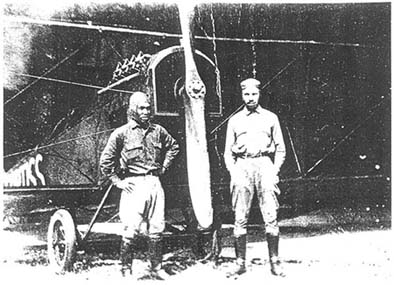PHILIPPINE
AIR SERVICE
1920 - 1921

Air
Service pilots Calvo and Abolencia at the Camp Claudio
beach
runway along with their Curtiss Jenny.
From
the position of the military, aviation was a critical element for the defense
of the islands. As early as
January,
1915 the Commanding General of the Philippine Department in Manila cabled
the War Department with the following concerns:
It
is believed that adequate aeronautical personnel and material are essential
to the defense of
Corregidor
against artillery attack, especially from the direction of Mariveles. Artillery
from these positions could be capable of destroying the gun defenses on
Corregidor. On the other hand, if the location of such artillery is established
by proper (aerial) observation, the gun defenses of Corregidor are sufficiently
strong to destroy such hostile artillery.
Further
the Commanding General stated:
While
the destruction of the primary gun defense of Corregidor by hostile artillery
might not by itself cause the fall of the place, it would at least render
Manila Bay available to a hostile fleet.
In
less than 30 years. General Douglas MacArthur would be faced with the very
same concern — Corregidor being shelled from the mainland, with little
to no air support to provide reconnaissance or, more important, offensive
capabilities.
After
the end of the First World War, U.S. Army biplanes began to reappear in
the skies over the Philippines as the Philippine .Department began to re-establish
and build its Aero Squadrons.
At
the same time, surplus military aircraft, Curtiss JN-4D Jennys and Curtiss
HS-IL/HS-2L Seagulls (a name applied by the Philippine Air Service) provided
the first opportunity to train Filipinos to fly and to establish the first
commercial air service.
Much
of the credit for the promotion and creation of the Philippines' indigenous
air service belongs to Major Joseph E.H. Stevenot, a longtime resident
of the Philippines. He had joined the U.S. Army in 1914 at the outbreak
of the First World War, with the rank of captain. He received his flight
training at Brooks Field in Texas and qualified as an aviator. Although
he did not serve in Europe during the war, he returned to the Philippines
and became the commander of the Philippine National Guard's Aviation Unit.
Major
Stevenot was an aviation visionary who regarded the Far East as a widespread
territory well
suited
for aviation and the rewards it could provide a country and an entrepreneur.
An active member of the Aero Club of the Philippines, and a tireless advocate
of aviation in the Philippines, he lobbied for the cause and convinced
business and government leaders of the long-term value and importance of
aviation for the country's commerce and defense.
After
the war, Stevenot convinced his former flight instructor, Alfred J. Croft,
to come to the Philippines and join him in a venture to train pilots and
sell aircraft. Stevenot saw aviation as a growth industry in the Philippines
and throughout the Far East. Aviation would provide the long-sought-after
opportunity for the Philippines to be connected through regular commercial
transportation of people and goods, as well as to create a dependable air
mail service. In addition, an aviation service could play a key role in
mapping the islands, and in training the first generation of Filipino military
pilots, all key objectives of the Philippine Insular Government and the
Governor General. |

